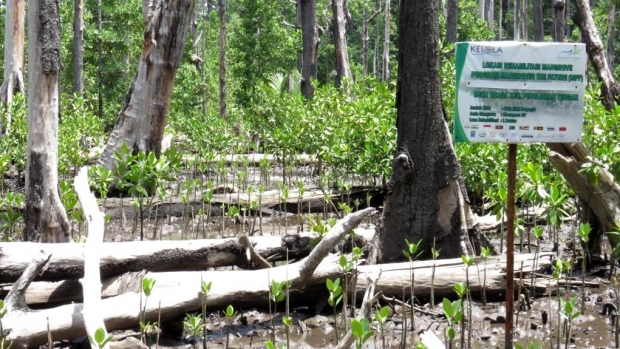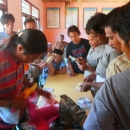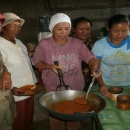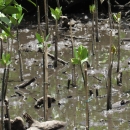Grants :: Small Grant Facilities :: Capacity Building & the Improvement of Community Economy through Sustainable Management of Coastal Resources in Deaga Village
Capacity Building & the Improvement of Community Economy through Sustainable Management of Coastal Resources in Deaga Village

Mangrove rehabilitation site at Deaga Village, Deaga Village, Bolaang Mongondow Selatan District, North Sulawesi Province © MFF IUCN
Objectives
- Capacity of the community group to manage coastal resources in Deaga village is strengthened;
- To improve coastal ecosystem health and to improve fishermen livelihood in Deaga village
Background
Deaga village has two main mangrove ecosystem clumps, dominated by wooden mangrove and nypah. Stable coastal areas and relatively low disturbance have been resulted in the good development of mangrove belt along coastal and river bank areas.
It is identified a total of 168 ha of mangrove ecosystems in Deaga village, consist of 168 ha mangrove areas and 62 ha of high density nypah. Only small areas remained suitably for rehabilitation programme.
Target beneficiaries
Fishing families in Deaga village.
Outputs
- Deaga village regulation on mangrove management was issued and formally applied on May 1st, 2015;
- 2 women’s groups (consisting of 20 members) were established;
- A report on coastal resource analysis;
- 30 community members received training on mangrove rehabilitation and took part on the rehabilitation activity;
- 20 community members received training on how to make sugar from Nypa;
- 30 fishermen used environmentally friendly fishing gears and committed to avoid destructive fishing practices.
- Women’s groups produced Nypa sugar, and marketed the sugar locally;
- 6,300 mangrove and 2,100 Terminalia cattapa seedlings were planted with 87% growth rate to rehabilitate 1 ha of mangrove and coastal areas.
Accomplishments and challenges
- . The following training activities had been implemented, prior to the implementation of the rehabilitation and livelihood activities:
- Two-day training on mangrove rehabilitation techniques;
- Two-day training on the production of sugar from Nypa tree, participated by 80 members. Prior to the training, intensive discussions were held with women's groups to provide introductory knowledge on the steps needed to be taken on sugar production from Nypa tree as well as the need to protect Nypa trees to ensure the sustainable supply. In addition, a village discussion on the current condition of local coastal areas had also been done, facilitated by Kelola. These were considered as the important step, as the activity was relatively new for most of the community group members.
- Two-day the training on the use of environmentally friendly fishing gears, facilitated by 2 trainers from Fishers Association;
- A total of 6,700seedlings of Rhizopora sp., Nypah sp. and Terminalia cattapa had been prepared in nursery, of which 6,300 wereon the beach rehabilitation areas. The second part of mangrove rehabilitation was done in the northern part of Deaga’s mangrove area (1 hectare), where local community believed that the area was destructed by the urine of vampire bats. No less than 40 people engaged on the planting of 4,000 mangrove propagules. The remaining 400 seedlings would be used for plant enrichment. Total rehabilitation areas: 5 ha;
- Kelola also facilitated the development of Village regulation on the use of and protection of Nypa. The first draft of document had been finalized by a team of 20 people representing village formal and informal leaders. Further steps would be public consultation, legal arrangement with district government office and the gazettal of the regulation to be publicly announced;
- A remark made by Head of Village that the MFF programme was one of (if not the only) external supports which allowed local communities to fully participate on every step of the decision making and implementation processes.
Contributions to cross-cutting themes
- Climate change and disaster risk reduction
6,300 mangrove and 2,100 Terminalia cattapa seedlings were planted to rehabilitate 1 ha of mangrove and coastal areas.
- Gender equality
Two-day training on the production of sugar from Nypa tree, participated by 80 members. Prior to the training, intensive discussions were held with women's groups to provide introductory knowledge on the steps needed to be taken on sugar production from Nypa tree as well as the need to protect Nypa trees to ensure the sustainable supply.
Lessons Learned
- Grantee should be equipped with basic organizational and financial management skills to ensure the submission of deliverables in a timely manner and in a proper format;
- In relation to livelihood activities/the initiation of small scale businesses, training on income generation followed by the production might take some time (going through some trials and errors). It is hard to estimate percentage of the benefit per month from the activities that instant, and the project period is also relatively short (10-12 months). The most reasonable outputs than can can be expected from these activities are knowledge sharing to the direct beneficiaries (groups involved) on how to process fish and other products to become commodities with more economic value and entrepreneurial spirit;
- Good communication with the local government will secure the land use for rehabilitation site (through the development of village regulation) in a long period of time and give full access to grantee/community organization to manage the area.
Country
Location
Deaga Village, Bolaang Mongondow Selatan District, North Sulawesi Province
Topic
Duration
6th May 2014 to 5th May 2015
MFF Grant Amount
IDR 197,000,000
Implementing Partner
KELOLA
Daseng Lolaro, Desa Tiwoho, Kec. Wori., Kab. Minahasa Utara – North Sulawesi Province
Contact person: Mr Temy Adtya, Programme Coordinator
Mobile: +6289697930060
Email address: themmydoali@gmail.com


